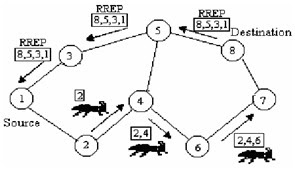ROUTING ALGORITHMS FOR ENERGY EFFICIENCY IN UNDERWATER WIRELESS SENSOR NETWORKS
INTRODUCTION:
The world contains 70% water. A very fine part of it is understood by us. Researchers are working hard to discover and contribute more and more for the wellness of the society. Underwater Networks are the major part of this. In Real, UWSNs are a network of sensor nodes extended over a very large area. A sensor node is a battery operated device used to collect and send data through sensors and can communicate with different sensor nodes according to different types of communication as acoustic mode, electromagnetic mode and free space optic mode.
The area we focused on is on electromagnetic mode of communication. The benefit of electromagnetic mode of communication is the energy of this wave is maximum in compare to the acoustic mode and free space optic mode of communication.
In UWSNs whenever a sensor node collects any data it forwards it to another node, this loop continues until the data reaches a node placed at surface known as sink node. The sink node finally transmits the data to a base station where data is being analyzed.
CHALLENGES :
We have proposed an effective routing algorithm to minimize the use of energy and to reduce the efforts in communication. Through this very project, we have encountered many challenges and risks that we tried to mitigate. Here are the major risks and challenges we faced in our project:
Battery life.The sensor nodes operate on batteries.
Environment.The very next problem we encountered is the continue motion of the
sensor nodes due to the fluid properties of water.
Energy.To communicate and transfer data among nodes energy is required which is obtained from battery inbuilt.
Clustering. There are various clustering approaches like hierarchical and partition clustering.
Routing.In transmitting data a high propagation delay is possible which is as
much as 5 times of terrestrial environment.
Fig.1. : Overview of Underwater Wireless Sensor Networks
Most common approaches for this problem is to
select random nodes as cluster heads and then collect and transmit data
accordingly. In
further rounds for each round this cluster heads are updated. For routing a
very common routing algorithm is leach protocol. Other approaches for the same
problem were Direct Routing where the data is sent directly to the sink node. The
previous approaches required a lot of energy for the system and also the
accuracy and lifetime was not up to the mark.
Our approach for this very Project is a
nature inspired algorithm and is a hybrid of genetic as well as ant colony
optimization algorithm.
The implementation of the algorithm is done in the environment provided
by Matlab. It provides a simulation environment where we can test real time
working of our implemented algorithm by providing the necessary data as input.
Preliminary Setup:
The working
conditions for underwater wireless sensor networks are assumed that the sensor
nodes are practically stable. Various nodes have been deployed over a certain
range of area (measured in meters).
Table 1.Characteristics used in our simulation
Parameters
Values
Eelec
50nJ/bit
Efs
10 pJ/bit/m2
Emp
0.0013 pJ/bit/m4
E0
0.5 J
k
2000 bits
EDA
50 nJ/bit/message
d0
88 m
a
4
b
2
g
2
d
4
initial value of ti,j
0.0001
initial value of hi,j
0.0001
METHODOLOGY:
CLUSTERING:
We divide the network into clusters and decide to choose an efficient Cluster Head (CH) for every cluster. We have used two clustering method GENETIC ALGORITHM , LEACH , and have implemented LEACH .
GENETIC ALGORITHM: The genetic algorithm is meta-heuristic optimization technique, which leads to produce good desirable results in many fields of applications. It is nature inspired algorithm, it is abstracted from real biological evolution -GENES, DNA, Etc. Here we use this algorithm to energy efficient clustering and cluster head selection in underwater wireless sensor networks. It focus on optimizing the given population and create more new optimal population of solution. From the given individuals, best solution will survive. It is a randomized search technique and primarily works on the following genetic features:
LEACH ALGORITHM:The first approach was the Leach Algorithm. In this algorithm the energy is divided equally between all sensor nodes in the network. After that the cluster is formed. In this protocol multiple clusters are formed of sensor nodes and one node defined as cluster head act as a node used for routing for every other nodes present in the cluster.
ROUTING METHOD:
ANT COLONY OPTIMIZATION: Ant colony optimization is a routing method for underwater wireless sensor. It mainly concentrate on providing the shortest path for the information to travel from source node to destination. It also make sure that energy of all the nodes in the network are consistently loose the energy of the nodes so that the network life is increased. The process is like an Ant searching for food source by increasing the pheromone level in that path then the other Ant will follow the same path increasing the pheromone level. Here the sender node will consider the possible nodes to send the information and which has the highest probability will get the information and the pheromone level of that part will be increased if the energy of node drains out below the threshold value it will take the next highest probability value.
EXPERIMENTAL RESULTS :
Figure 5: Nodes Localization in 3D Underwater Wireless Sensor Network Based on LEACH and Ant Colony Algorithm.
The Results obtained shows the different
nodes which are categorized into cluster heads, advanced nodes(which will later
become cluster heads), normal sensor nodes scattered all over.
Our algorithm has successfully reduced the
cost of energy required to transfer data packet from one sensor node to another
sensor node. Also, it reduces the overall load of the network and data traffic
and it increases the overall lifetime of the network.





Comments
Post a Comment